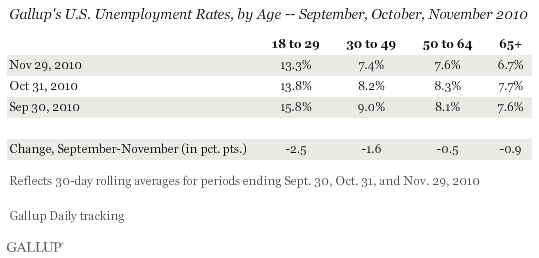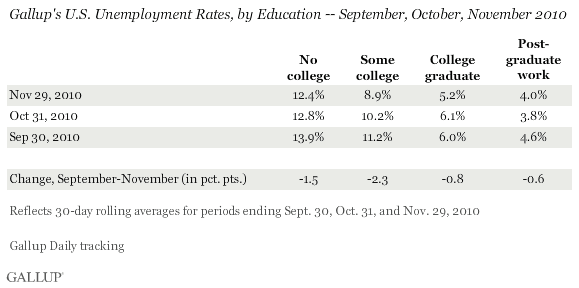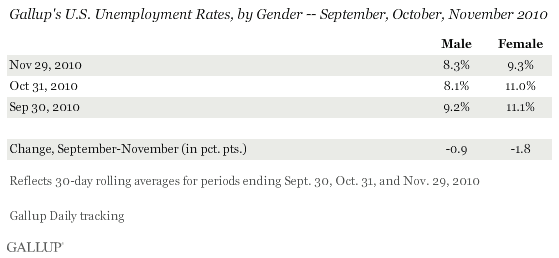PRINCETON, NJ -- Gallup's monitoring of the U.S. employment situation, without seasonal adjustment, finds the jobs situation improving among many segments of the workforce, with unemployment among Americans aged 18 to 29 falling the most since September. Unemployment is also down among 30- to 49-year-olds and, to a lesser degree, among older age groups.

Gallup's measure of unemployment is based on a rolling average, updated daily to take into account the most recent 30 days of interviewing, with each 30-day average consisting of more than 18,000 interviews. Gallup's November update found unemployment down to 8.8% from 9.4% in October and 10.1% in September. This improvement is seen across most demographic groups, but in some more than others.
After 18- to 29-year-olds, Gallup finds the second-largest decrease in unemployment among those with some college education, down to 8.9% in November from 11.2% in September. Unemployment also fell among Americans with no college education, to 12.4% in November from 13.9% in September.

The unemployment rate among women also fell, to 9.3% in November from 11.1% in September, with most of the improvement coming between October and November. Men, on the other hand, saw the most improvement between September and October, ultimately improving to 8.3% in November from 9.2% in September.

In Real Time, Without Adjustment, the Jobs Situation Is Improving
In sharp contrast to the government's report Friday that the U.S. unemployment rate increased to 9.8% in November from 9.6% in October, unemployment as measured by Gallup declined to 8.8% in November. This is down from 9.4% in October and 10.1% in September. Because Gallup's U.S. unemployment rate is not seasonally adjusted, some of the late October and November improvement is likely the result of retailers hiring for the Christmas holidays. The demographic data reveal that younger Americans and those with some college education are among those now finding work.
Still, this unadjusted measure may be a better indication of actual labor market conditions than the seasonally adjusted measure reported by the government. Seasonal adjustments are useful for economists to attempt to filter out seasonal effects from underlying data trends, but they are hard to calculate when the U.S. economy has been depressed for about three years. Further, the underemployment rate without seasonal adjustment can be seen as a better indicator of the hiring and firing taking place in the economy.
Additionally, the government's data reflect job market conditions in mid-November. In contrast, Gallup's data measure job conditions throughout the month. In turn, this means Gallup's measure is more up-to-date than the government's report.
Regardless, Gallup data suggest the jobs situation showed substantial improvement in late October and that this improvement continued throughout November. These results seem more consistent with the other signs in the U.S. economy that suggest modest economic improvement than does the government's most recent unemployment report.
Gallup.com reports results from these indexes in daily, weekly, and monthly averages and in Gallup.com stories. Complete trend data are always available to view and export in the following charts:
Daily: Employment, Economic Confidence and Job Creation, Consumer Spending
Weekly: Employment, Economic Confidence, Job Creation, Consumer Spending
Read more about Gallup's economic measures.
Survey Methods
Gallup classifies American workers as underemployed if they are either unemployed or working part time but wanting full-time work. The findings reflect more than 18,000 phone interviews with U.S. adults aged 18 and older in the workforce, collected over a 30-day period. Gallup's results are not seasonally adjusted and tend to be a precursor of government reports by approximately two weeks.
Results are based on telephone interviews conducted as part of Gallup Daily tracking Oct. 31-Nov. 29, 2010, with a random sample of 18,272 adults, aged 18 and older, living in all 50 U.S. states and the District of Columbia, selected using random-digit-dial sampling.
For results based on the total sample of national adults, one can say with 95% confidence that the maximum margin of sampling error is ±1 percentage point.
Interviews are conducted with respondents on landline telephones and cellular phones, with interviews conducted in Spanish for respondents who are primarily Spanish-speaking. Each daily sample includes a minimum quota of 150 cell phone respondents and 850 landline respondents, with additional minimum quotas among landline respondents for gender within region. Landline respondents are chosen at random within each household on the basis of which member had the most recent birthday.
Samples are weighted by gender, age, race, Hispanic ethnicity, education, region, adults in the household, cell phone-only status, cell phone-mostly status, and phone lines. Demographic weighting targets are based on the March 2009 Current Population Survey figures for the aged 18 and older non-institutionalized population living in U.S. telephone households. All reported margins of sampling error include the computed design effects for weighting and sample design.
In addition to sampling error, question wording and practical difficulties in conducting surveys can introduce error or bias into the findings of public opinion polls.
For more details on Gallup's polling methodology, visit www.gallup.com.

